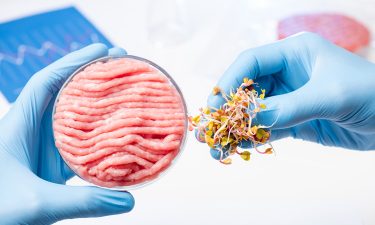Leveraging R&D to perfect plant-based
- Like
- Digg
- Del
- Tumblr
- VKontakte
- Buffer
- Love This
- Odnoklassniki
- Meneame
- Blogger
- Amazon
- Yahoo Mail
- Gmail
- AOL
- Newsvine
- HackerNews
- Evernote
- MySpace
- Mail.ru
- Viadeo
- Line
- Comments
- Yummly
- SMS
- Viber
- Telegram
- Subscribe
- Skype
- Facebook Messenger
- Kakao
- LiveJournal
- Yammer
- Edgar
- Fintel
- Mix
- Instapaper
- Copy Link
Posted: 7 May 2020 | Sam Mehmet (New Food) | No comments yet
Plant-based eating is sweeping the world, and emerging products are beginning to experiment with textures, flavours and colours. New Food’s Junior Editor, Sam Mehmet, hears from Michael Leonard of Motif FoodWorks about the importance of research and development.


The plant-based phenomenon has arrived, introducing a new kind of consumer – flexitarians. No longer are such foods considered strictly for vegans or vegetarians. Owing to its health and sustainability credentials, alongside innovative textures, tastes and appearance, plant-based has become a widely accepted meal option.
Here, Michael Leonard, Chief Technology Officer and Senior Vice President of Motif FoodWorks, explains the integral role that research and development (R&D) plays when it comes to perfecting properties such as texture, flavour and colour.
Motif is an animal-free ingredient innovation company, which uses food science to uncover what makes the food we love taste and perform well.
The compromises between plant-based and animal products are few and far between.
“We are looking to make the plant-based eating experience better for everybody and help improve the quality of our customers’ products across the board,” Leonard said. “We focus mainly on meat and dairy alternatives; looking at attributes like texture, flavour and colour improvement.” According to Leonard, these three characteristics can be big barriers to people’s decision to consume plant-based products – whether occasionally or full time.
He points to the evolution of technology as a key driver, noting that industry now has the ability to make “great tasting animal-free options”, but admits there is still a long way to go – and that is where he feels Motif can play an important role.
Animal-free product demand
“I think there are a lot of historical examples of short-lived trends and fads in the food industry – and having been in the industry for about 16 years, I have seen my fair share of them!” Leonard said. “But what I think is unique about the plant-based movement is that it is really ‘value-driven’; people are choosing to adopt a truly plant-based lifestyle. I would extend that not just to food but to other choices people make in their lives; people want to do better for themselves and for the environment. I think the level of agency that individuals feel today about their ability to make an impact is growing, and it is maybe at a higher level than it has been in the past.
“Plant-based foods and meat alternatives are not new ideas, but I think the technology that is available for food ingredient design and processing has got a lot better. I must credit companies like Impossible and Beyond for all the work they have done to advance this and to build awareness and credibility of the technology for what is possible.”
Consumer expectations


However, he believes we are seeing an increasing number of consumers who are willing to try new and different things. “The marketing has also got to a point where unique attributes of plant-based foods are being highlighted versus making comparisons to existing food ideas.
We have to deliver an industry that improves the nutritional quality of these foods.
“In terms of the ingredient design and quality of produce, such as plant proteins, soy and pea, the technology has really improved. It has reached a point where they can be used in formulations more effectively without trade-offs, or without the expended trade-offs that we used to see with regard to flavour and texture.
“The processing technology has also moved forward; the ability now exists to extrude, combine ingredients and produce product forms that are actually appealing.”
Leonard believes that the compromises between plant-based and animal products are now few and far between, but there is still further R&D needed. “How do we design ingredients and tune interactions in those foods that really improve the eating quality?” he said, “that is one thing we are focused on.”
He continued: “The first step is to understand what the specific targets are that you want to address, and that comes from in-depth sensory research and an understanding of where consumers see the biggest deltas in texture and eating quality.
We want to see an increased adoption of plant-based foods across the board and we understand that if the food still tastes good, it does not matter what social commitment you might have.
“The second thing is to look at the basic physics and what gives rise to these issues. So going back to the burger example, if we consider ground beef and the way the fat, protein and water are arranged within that beef patty, compared to the same behaviour of the fat, protein and water in a soy-based burger, what are the key interactions that are driving those differences? And what elements of ingredient design could we manipulate to help improve the eating quality?


Plant-based chicken meal
“So, we look at it holistically: ‘how do we need to handle the fat, protein and water? How do we tune those interactions?’ We can do that through ingredient design and by incorporating different types of fat systems into the product. Incidentally, that is one of the key areas of study that we recently kicked off with the University of Queensland – to really understand the physics of oral processing of plant-based meat, rather than just relying on a sensory panel to tell you. We are getting physical data of mechanical forces that are at play when the products are actually consumed and describing that quantitatively, so that we can use that to design better ingredients and better systems.”
Motif also recently signed a partnership with the University of Massachusetts Amherst (UMass) and its Department of Food Science Professors, Julian McClements and Eric Decker, two of the world’s foremost food scientists. “They are helping us set up a programme to evaluate the physical and chemical properties of animal-free food ingredients at a very small scale,” Leonard said. “We need to be able to understand the properties of our ingredients on a very small scale and at a very fast pace.” This should enable Motif to identify the best candidates to develop and deliver its high throughput commitment.
Creating textures
“If you look at the nutritional label of plant-based meat, you are going to see a list of things with words that are hard to understand and pronounce,” Leonard explained. “To make up for the absence of animal proteins or animal fats that are very functional and provide a lot of benefits in terms of water, protein and fat interactions, you have to include ingredients such as gums, stabilisers and agents that help promote water‑binding and fat‑binding. Many of those ingredients are artificial and unfamiliar to consumers.
In terms of the ingredient design and quality of produce, such as plant proteins, soy and pea, the technology has really improved.
“It is a bit ironic because we talk about the decision to adopt the plant-based lifestyle as one that is better for people’s health and better for the planet, but if you look at a lot of alternatives out there in terms of nutrition, you are not necessarily getting the benefit of a cleaner label and better nutritional profile from the products,” he continued. “We see that as another opportunity – by being able to provide this functionality of animal ingredients in an animal-free way. There is potential for our customers to clean up the label, and to maybe avoid using gums, thickeners and other stabilisers.”
The future of plant-based
Leonard believes that once this “period of excitement” that currently surrounds plant-based has calmed down, people will start to question whether this diet is truly more nutritious.
“It is only so long before the nutritional reality sets in. I think, for the movement to be sustainable, we have to deliver an industry that improves the nutritional quality of these foods, which is another area that we see Motif being involved in.
“In five years’ time, we believe Motif can have a really positive impact on the adoption of plant-based foods by providing options to customers that enable them to potentially clean up the label, and improve the eating experience. We want to see an increased adoption of plant-based foods across the board and we understand that if the food still tastes good, it does not matter what social commitment you might have. If you do not like the taste of your food, you are not going to buy it again.”
He continued: “Our mission is to deliver against taste and nutrition; in five years we expect to see that we have made a difference and helped to move the needle on adoption and growth of the industry through the ingredient science and products that we deliver.”
Biography


Issue
Related topics
Free From, Ingredients, New product development (NPD), Plant based, Research & development, Technology & Innovation









